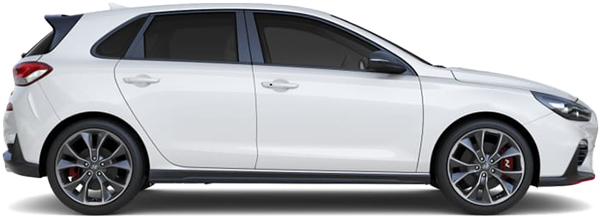The Comparative Analysis :
Mitsubishi Lancer Sportback 2.0 16V Turbo Ralliart TC-SST (09 - 11) vs. Hyundai i30 N Performance Project C (19 - ..)
€ 36,000

€ 43,000

€ 36,000
Base Price ⓘBase price of a new vehicle with standard equipment in Germany at market launch.
€ 43,000
ⓘBase price of a new vehicle with standard equipment in Germany at market launch. Price Info
Vehicle Dimensions
The dimensions of these vehicles differ considerably. The Mitsubishi Lancer Sportback 2.0 16V Turbo is 21.4 cm longer, 3.5 cm narrower and 7.6 cm taller than the Hyundai i30 N Performance.
Mitsubishi Lancer Sportback 2.0 16V Turbo
Hyundai i30 N Performance
1515
1760
2044
1439
1795
2050
1760 mm
Width
1795 mm
2044 mm
Width Incl. Mirrors
2050 mm
1515 mm
Height
1439 mm
2635
4585
2650
4371
4585 mm
Length
4371 mm
2635 mm
Wheelbase
2650 mm
Vehicle Weight
Mitsubishi Lancer Sportback 2.0 16V Turbo
Hyundai i30 N Performance
No data
Kerb Weight
1470 kg
No data
Gross Vehicle
Weight
Weight
1910 kg

Weight Difference:
No data
No data

General
Mitsubishi Lancer Sportback 2.0 16V Turbo
Hyundai i30 N Performance
CY0
Generation
PDE
Hatchback
Car Body Style
Hatchback
Unleaded (95 RON)
Fuel Type
Unleaded (95 RON)

Permanent all-wheel drive
Drive
Front-wheel drive

6-speed dual clutch transmission
Transmission
6-speed manual transmission
Engine
Mitsubishi Lancer Sportback 2.0 16V Turbo
Hyundai i30 N Performance
Straight-four petrol engine with turbocharger
Engine Type
Straight-four petrol engine with turbocharger
4
Valves
4
4
Cylinders
4
1998 CC
Engine Capacity
1998 CC
237 bhp
at 6000 rpm
Power
271 bhp
at 6000 rpm
Mitsubishi Lancer Sportback 2.0 16V Turbo
237 bhp
271 bhp
Hyundai i30 N Performance
343 NM
at 2500 rpm
Max. Torque
353 NM
at 1750 rpm
Mitsubishi Lancer Sportback 2.0 16V Turbo
343 NM
353 NM
Hyundai i30 N Performance
Performance
Mitsubishi Lancer Sportback 2.0 16V Turbo
Hyundai i30 N Performance
137 mph
Maximum Speed
155 mph
7.1 sec
Acceleration 0 to 62 mph
6 sec
62 mph
62
mph
mph
99 m
0.000 sec

Mitsubishi Lancer Sportback 2.0 16V Turbo
62 mph
62
mph
mph
83 m
0.000 sec

Hyundai i30 N Performance
▶ REPLAY
No data
Weight-to-Power Ratio
5.42 kg/bhp
Mitsubishi Lancer Sportback 2.0 16V Turbo
0 kg/bhp
5.42 kg/bhp
Hyundai i30 N Performance
Fuel Economy / Emissions
Mitsubishi Lancer Sportback 2.0 16V Turbo
Hyundai i30 N Performance
Fuel Economy
28 mpg
combined
36 mpg
Mitsubishi Lancer Sportback 2.0 16V Turbo
28 mpg
36 mpg
Hyundai i30 N Performance
20 mpg
city
27 mpg
35 mpg
motorway
46 mpg
59 L
Fuel Tank Capacity
50 L
359 mi
Range
398 mi
Mitsubishi Lancer Sportback 2.0 16V Turbo
359 mi
398 mi
Hyundai i30 N Performance
Environmental Impact
193.3 kWh
Total Energy Consumption
per 100 miles ⓘThe total energy consumption per 100 miles is the amount of energy consumed by a vehicle when burning fuel or using electricity per 100 miles (final energy), and the energy required to produce the appropriate amount of fuel or electricity (primary energy).
per 100 miles ⓘThe total energy consumption per 100 miles is the amount of energy consumed by a vehicle when burning fuel or using electricity per 100 miles (final energy), and the energy required to produce the appropriate amount of fuel or electricity (primary energy).
147.7 kWh
Mitsubishi Lancer Sportback 2.0 16V Turbo
193.3 kWh
147.7 kWh
Hyundai i30 N Performance
Euro 4 / Euro 5
Emission Standard
Euro 6d-TEMP-EVAP-ISC (WLTP) 36CH, 36CI, 36DG
243 g/km (NEFZ)
CO2 Emissions
188 g/km (WLTP)
Practical Convenience
Mitsubishi Lancer Sportback 2.0 16V Turbo
Hyundai i30 N Performance
5
Doors
5
5
No. of Seats
5
No data
Maximum Payload
440 kg
288 L
Boot Capacity
381 L






1349 L
Boot Capacity (Seats Down)
1287 L



















